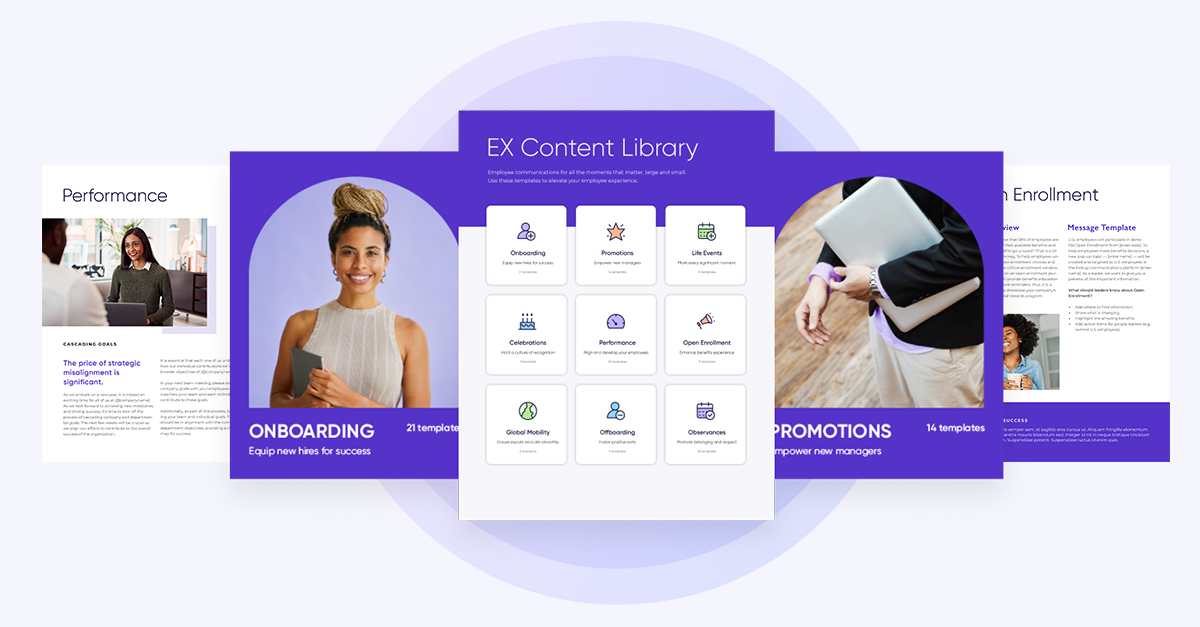For many internal communicators, evaluating metrics is a weak spot. We discovered that only 56% of survey respondents tracked website analytics, 44% looked at email clicks, and 19% didn’t measure employee communications at all. Moreover, only 22% were confident that their internal communication strategy was effective in improving their content.
This lack of confidence translates into how little the data and resulting insights were used or shared. While more than two-thirds of communicators shared their internal communication metrics with their company’s executive teams, a staggering 70% reported that their leaders didn’t even ask for their metrics. Internal communications data was given very little attention, and sometimes completely ignored.
Employee feedback isn’t being heard and communication efforts are not being acted on. That needs to change.
Using data and analysis to drive success
As you begin your internal communications measurement process, consider how you will use information to inform your internal communications strategy and meet your business objectives.
Components of data driven internal communications
Look at both qualitative and quantitative data
Focus groups, surveys, and interviews are considered qualitative and offer insights into your employees’ preferences. However, what someone says on a survey doesn’t necessarily match their actions. This is where quantitative data, such as regular engagement or clicks, is useful.
For example, some employees might say they prefer written updates from management but statistics show that corporate videos get over 60% higher engagement. If you look at both datasets, you can conclude that the people who don’t love video are likely to answer that way in a survey.
But that doesn’t mean you should stop doing video! This is how qualitative and quantitative data complement each other and help you see the complete picture.

What is cohort analysis?
It provides insight into a particular audience segment and their behavior. Cohorts share common characteristics within a defined time span. For example, you could look at active users of your branded internal communications app.
Cohort 1 would be new users who recently downloaded the app, and Cohort 2 would be active users for the last 90 days.
Determine the question you want to answer. For example, “How do I improve retention?” Identify a specific action such as how often these two cohort’s employees return to the app over the course of two weeks. Then, you compare each cohort’s behavior within that time frame. You’ll see differences between each group at points in time and know how better to serve all users.
Benchmarking your results
Benchmarking is used to evaluate performance compared to a standard set of measurement metrics. Internal communications has not typically had its own set of benchmarks, but Firstup is leading the charge in this domain. Our benchmarks look at a full set of program information from all customers weekly and monthly.
First, decide what you want to benchmark. What are your goals? For example, if you’re focused on increasing employee engagement, you would benchmark retention over a time frame and look how your retention rates compare to other programs like yours. How do your click-through rates on content and monthly active users compare?

By setting a control of how your communications perform, you can measure future content against this benchmark. Over time, you’ll better understand your audience and establish precedence to measure internal communications and prove your team’s value to overall business goals.
Setting your internal communications goals
Every enterprise and team is unique, and metrics for your internal communications strategy will be specific to your situation. This is where measurement will narrow focus to your desired outcomes and resources. It’s important to set key performance indicators and objectives that are actionable to work toward improving.
Get started with these steps to establish your internal communications goals.
1. Identify your company’s goals
What are your business strategies? Be sure you know your company-wide objectives to inform and align your communications goals.
2. Establish objectives for your communications
Start with your current campaigns or initiatives. Ask these questions:
- What campaign or initiative do I want to run?
- Which channels are best for this campaign?
- What do I hope to achieve?
- How many employees do I need to reach?
- How will I measure success?
For example, you have a company initiative to reach frontline workers. You have a communications campaign to host your town hall via live stream, and you want to engage those hardest to reach.
How will you define success? Think about your past town halls; what did you do? Did your frontline employees participate? Were there reasons why participation was low? What would you do differently?

One goal could be to increase the number of frontline attendees, so establish a percentage to define the goal. For example, a 50% attendance rate (from this group) could be your achievement.
3. Review what metrics are available and how to use them
Now that you’ve set objectives and defined success, you’ll create your strategy on how to measure your campaign. First, break down your campaign activities to plan how best to communicate. Consider:
- Which channels are best for this particular campaign?
- How will I test this?
- How will I measure performance on that channel?
- What are the metrics specific to the channel?
Measurements depend on the way you send out your communications. Each channel you plan to use – intranet, internal communications app, company email – has a different metric to measure employee engagement.
For example, email performance is measured by open rates, click-through rates, and more. If you’re using your branded communications app to send messages, your metrics would be engagement-based, measured with likes, comments, etc.
By measuring and analyzing your outcomes, you’ll also establish a champion channel strategy.
4. Determine your internal communication metrics
Identify Key Performance Indicators (KPIs) to track the progress of initiatives in relation to company-wide objectives. A KPI is a measurable value that demonstrates whether an enterprise is achieving its goals. For example, as internal communications professionals, your communication KPIs could be increasing engagement by 20% a year.

Communications metrics, by comparison, measure the success of a specific campaign action, like a piece of content. The difference is that KPIs usually connect to a larger business strategy, whereas metrics are more tactical. Both must be quantifiable.
Demonstrate to your entire organization the impact of your internal communications and how they drive business outcomes by sharing both your KPIs and your metrics.
- Set a Baseline
- You’ll need to figure out what you’re measuring to determine its effectiveness. Take stock of what metrics your organization is following, how they are followed, and what the current numbers indicate. Set “ground zero” numbers that will serve as your reference point to measure your work going forward.
- You’ll need to figure out what you’re measuring to determine its effectiveness. Take stock of what metrics your organization is following, how they are followed, and what the current numbers indicate. Set “ground zero” numbers that will serve as your reference point to measure your work going forward.
- Responses and Feedback
- Surveys can be the best way of understanding what employees have engaged with. Typically, people are willing to provide honest answers if they feel there is anonymity. No one wants to ‘call out’ a supervisor for not doing their job or a company for lacking in clear internal communication.
- Asking questions like ‘On a scale of 1 to 10, how has this company effectively demonstrated its ability to communicate internally?’ is an objective way to get information. Also, allowing for comments lets employees elaborate on an unclear topic. Do not just send one survey to all employees; make sure to segment out by job/title/location and send surveys tailored to positions. Be sure the questions are clear with nothing open to interpretation. Another tactic is to run in-person focus groups to generate conversations that dig into issues.
- Surveys can be the best way of understanding what employees have engaged with. Typically, people are willing to provide honest answers if they feel there is anonymity. No one wants to ‘call out’ a supervisor for not doing their job or a company for lacking in clear internal communication.
- Track Engagement
- Employees may receive information but are they reading it? Implementing an internal communications platform that tracks employee engagement enables an organization to identify concerns. Employers can then better understand a company’s weaknesses and act upon them. In the modern workplace, it is necessary to use digital tools to track every aspect of a company’s performance, including communication.
- What kind of engagement numbers are tracked? If you asked most managers or human resources professionals, they would say email open rates or intranet logins. However, a more effective way of measuring might be email CTRs or shares. Open rates and intranet logins only show that an employee is aware of the information being distributed. But, measuring CTRs, or company news, that is shared, indicates that your employees are truly engaging with your message and communication strategy.
- Employees may receive information but are they reading it? Implementing an internal communications platform that tracks employee engagement enables an organization to identify concerns. Employers can then better understand a company’s weaknesses and act upon them. In the modern workplace, it is necessary to use digital tools to track every aspect of a company’s performance, including communication.
- Turnover
- Employees who are happy with their employers tend to stay in the same job for a longer time. And unhappy employees begin to look elsewhere for work. By tracking a company’s turnover rate, you can better understand the effectiveness of your internal communication. When employees feel like they’re “in the know,” they feel a greater sense of respect and trust from their employers. If not, then employees will lose their enthusiasm for a company. This reduces productivity and eventually leads to employee turnover. This is an easy KPI to track.
- Employees who are happy with their employers tend to stay in the same job for a longer time. And unhappy employees begin to look elsewhere for work. By tracking a company’s turnover rate, you can better understand the effectiveness of your internal communication. When employees feel like they’re “in the know,” they feel a greater sense of respect and trust from their employers. If not, then employees will lose their enthusiasm for a company. This reduces productivity and eventually leads to employee turnover. This is an easy KPI to track.
- Reaching employees
- This internal communication KPI is often underappreciated. Two of the biggest issues in modern digital workplace communication are the number of dispersed workers and channel adoption rates of the current company intranet systems. Almost one-third of workers never visit the intranet, and 43 percent of them work from a remote location at least part time. Measuring the percentage of employees who can be reached may be more important than any other metric. If a company memo is sent out and nobody reads it, does it make an impact?
- This internal communication KPI is often underappreciated. Two of the biggest issues in modern digital workplace communication are the number of dispersed workers and channel adoption rates of the current company intranet systems. Almost one-third of workers never visit the intranet, and 43 percent of them work from a remote location at least part time. Measuring the percentage of employees who can be reached may be more important than any other metric. If a company memo is sent out and nobody reads it, does it make an impact?
- Employee Advocacy
- Another overlooked internal communication KPI is Employee Advocacy, which goes hand-in-hand with employee engagement. Transforming your employees into passionate advocates for your brand can make a huge impact. When employees feel more connected to the organizational mission, they’re more likely to become advocates. This is important in helping you retain your top talent and increase productivity.
5. Choose the cadence to measure success
Once you know what communication metrics you’re tracking, record them over a period of time using your Firstup dashboard or a spreadsheet to evaluate your communications. For example, if you’re measuring video performance on your branded internal communications app, you’re looking at impressions, views, and engagement.
Using your workforce communications platform or spreadsheet, note the metrics you want to evaluate. Then add the values over a time period. Perhaps every week, you’ll document the video content’s performance. Then, you’ll benchmark and determine how successful you are, and you can compare it to metrics from other posted videos.

Later, you’ll analyze and create insights that will help you identify improvement opportunities. You may recognize that video content on your branded internal communications app is mostly watched when it’s new and may decide to measure its performance during this time period as an indicator of success. You’ll make more discoveries, such as the best types of content, length, time to post, etc., and you’ll think of ways to test your content ideas to improve.
Tracking internal communications metrics with Analyze
We provide the data so you can thrive amid major changes in your workforce and technology. The Analyze dashboard helps you uncover what’s resonating with your workforce – by location, function, tenure, line manager, etc. It uses intelligence to do internal communication analysis and optimize the delivery of communications to drive your desired business outcome.
Every executive needs information to make the best decisions for their business. We want you to be able to provide communications analytics and insights – and show how this intelligence drives the business.
“We look forward to tracking strategic initiatives and how they are resonating with our different employee groups around the world. Getting the right message to the right employees and partners — and tracking the results — is a key driver for our business.“
Norman Rice, COO, Extreme Networks
That’s why we created How to Measure Internal Communications, a step-by-step guide with everything you need to know about internal communication metrics. We address why measuring communications is essential, what and how to measure, and what actions you can take to build your internal communication strategy.
Our goal is to empower the communications team to embrace analytics, so they can take the necessary steps forward to be a leading content creator, communicator, and internal marketer to reach every employee with the right message at the right time as well as garner employee feedback.
How can internal communications improve the employee experience?
One way to think of metrics and analytics is as a continuous stream of insights or a feedback loop. You benchmark your activities as a baseline and then measure over time— monthly, quarterly, yearly, etc. Soon enough you’ll be able to make real-time modifications to your strategies based on what employees and leaders respond best to.
Get our latest infographic: How to build a better employee email, which shows you how to start engaging with employees, instead of just filling up their inboxes.
The concept of measurement is scary for many communicators, but your employees, leaders, and organizations need you to make this transformation. The rest of your company most likely operates this way, and this is your opportunity to step up and claim that seat at the table you deserve.
You can use all the insights and learnings about your workforce in two distinct ways: One, knowing what will motivate and boost employee morale will help you gauge whether you’re improving the employee experience. Two, you will be able to measure organizational alignment, measuring whether employees are responding to leadership mandates and understanding their purpose.
Using data to address communications challenges
As you work toward improving employee experience and driving alignment, you’ll recognize what workers need to thrive. Then, you can personalize your communications and deliver the relevancy employees seek:
- What content and information do they care about?
- What information do they need to know?
- What is their preferred communications channel?
- Does the day or time of day when sent matter?
Employees want and expect targeted, relevant content coming from internal communicators. When you take steps to measure the value of comms, your entire company will benefit by meeting broader business goals.
Conclusion
Here are five steps to kickstart your internal communications measurement strategy:
- Highlight problems that need to be solved, such as understanding employee needs.
- Look at the channels you use. What do you need to measure and which team members will you assign these tasks to?
- Establish a methodology and workflow for performing a continuous analysis.
- Align your findings with your team, incorporate feedback, and define actions that can be taken.
- Review and revise the process to ensure a level of integrity, analysis, and a constant flow of insights and action plans.
Get our updated How to Measure Internal Communications eBook today. Learn what a successful communication program looks like and start tracking your communications metrics.






